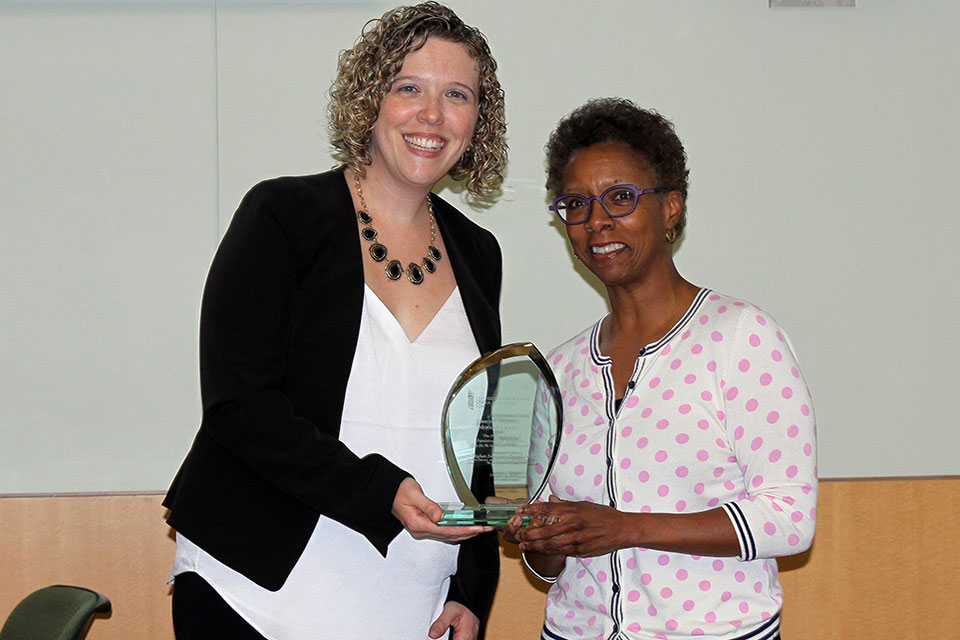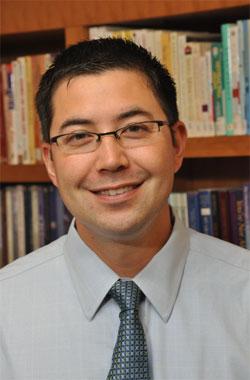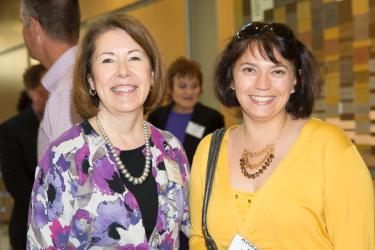Balassone Lecture Spotlights Pharmacists Role in Improving Care for Underserved
Dr. Steven W. Chen discusses his efforts to improve health outcomes and advance pharmacy practice through innovative pharmacy services for underserved populations.
By Malissa Carroll
November 15, 2016
Steven W. Chen, PharmD, FASHP, FCSHP, FNAP, associate professor and chair of the Titus Family Department of Clinical Pharmacy and William A. and Josephine A. Heeres Endowed Chair in Community Pharmacy at the University of Southern California School of Pharmacy, delivered the annual Francis S. Balassone Memorial Lecture at the University of Maryland School of Pharmacy on Oct. 24. Titled “Improving Health Outcomes While Advancing Pharmacy Practice through Innovative Pharmacy Services for the Underserved,” the lecture spotlighted the efforts of Chen and his team to integrate comprehensive clinical pharmacy services into local safety net clinics – clinics that offer low cost or free health care services to underserved and uninsured populations – and the impact of those services on patients’ health care quality, safety, and cost.
“Before I became involved with this initiative, I did not have much knowledge or experience addressing the unique health care needs of underserved populations,” said Chen. “However, in the more than 12 years since this project launched, it is a topic about which I have become very passionate. I know that the faculty, staff, and students at the University of Maryland School of Pharmacy are also involved in a wide range of projects designed to bring pharmacy services to underserved individuals in the local community, and it is my hope that we will be able to learn from each other and continue this important work at our respective institutions.”
Speaking about the evolution of his team’s work to bring clinical pharmacy services to safety net clinics, Chen noted that the project started small, with just three clinics and a $150,000 grant from the Health Resources & Services Administration (HRSA) to help identify areas of greatest need. Finding a lack of accountable medication use that spanned all three clinics, Chen and his team saw an opportunity for pharmacists to get involved. The team integrated clinical pharmacists into each clinic, where they demonstrated a measureable impact on both patient care and medication cost savings, even helping one clinic decrease its medication spending from $2 million to $400,000 in one year.
“We put the money that we saved back into our work to justify additional pharmacy positions for our clinics,” said Chen. “A project that started with one clinical pharmacists now boasts three because our efforts convinced others of the value associated with having a pharmacist on the health care team, both in terms of medication spending and quality outcomes for our patients.”
After experiencing a number of other successes with their project, Chen and his team received a $12 million grant from the Center for Medicare & Medicaid Innovation that allowed them to further expand their efforts, staffing 20 safety net clinics across Los Angeles with a clinical pharmacy team that included a clinical pharmacist, pharmacy resident, and clinical pharmacy technician. The grant also helped fund a telehealth clinical pharmacy team to provide pharmacy services to patients at smaller clinics using virtual technology, as well as the development of advanced training programs for pharmacy residents and technicians.
Within three years, Chen and his team had enrolled 6,000 patients in the project, which targeted individuals who had been diagnosed with chronic illnesses, had a history of hospital admissions, and were at the highest risk for readmission. From those 6,000 patients, the team identified and resolved more than 60,000 medication-related problems. Chen noted that the most common problem encountered by the pharmacists was inappropriate or ineffective drug therapy, which translates to patients receiving the wrong medication for their illnesses, the wrong dose of a medication, or no medication for a known health condition. “The results were a bit alarming, but we showed that there truly is a gap that pharmacists can fill as members of the health care team,” said Chen.
Chen also noted that the success that he and his team experienced with their project can be translated across health care settings if health care professionals work together to target the appropriate patients for pharmacy interventions. He described how he is currently partnering with a number of organizations to continue and expand initiatives that bring medication therapy management services to the patients who need them most, noting that there are still some challenges that must be addressed.
“For the right patients, our interventions have been shown to lower medication costs and improve health outcomes,” said Chen. “However, one of the most important obstacles that we must now overcome is changing others’ perceptions about the impact pharmacists can have as members of the health care team. Pharmacists have an image issue. We are members of a highly skilled profession that are not being leveraged to our full potential, and it is up to us to change that attitude not only for the benefit of our profession, but for our patients as well.”



